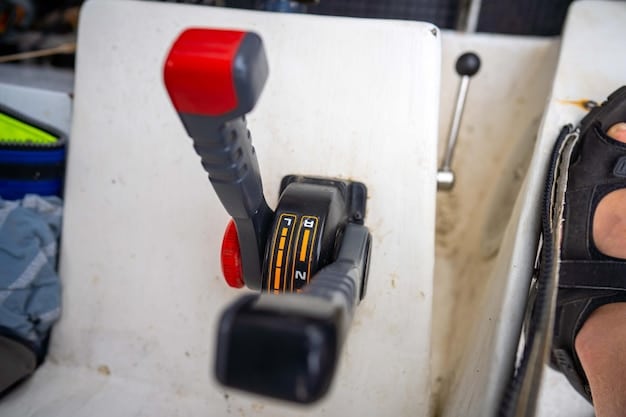Jet Ski Safety Checklist: 10 Essential Items for Watersports Safety

Ensuring personal watercraft safety necessitates a comprehensive pre-ride inspection, focusing on critical components and adherence to regulations to mitigate risks and enhance operational reliability for all riders.
Embarking on a jet ski adventure promises exhilaration and freedom on the water, but responsible thrill-seeking begins long before the engine roars to life. A diligent pre-ride check is not merely a formality; it’s a critical safety measure that can spell the difference between an unforgettable day and a potentially dangerous mishap. This Jet Ski Safety Checklist: 10 Essential Items to Inspect Before Hitting the Water is your comprehensive guide to ensuring every component is in prime condition, fostering both a safe and enjoyable experience for all onboard.
Understanding the Importance of a Pre-Ride Inspection
Before launching any personal watercraft (PWC), a thorough pre-ride inspection serves as the foundation for safe operation. This isn’t just about avoiding mechanical failures; it’s about safeguarding lives, preventing accidents, and ensuring compliance with maritime regulations. Neglecting even a minor check can lead to unforeseen complications on the water, turning a recreational outing into a challenging situation.
Mitigating Risks and Enhancing Safety
Each item on a safety checklist is designed to address a potential risk. From verifying fuel levels to checking the hull for damage, every step contributes to a holistic safety approach. A well-maintained PWC is less likely to experience breakdowns, reducing the chances of stranding or collisions. Moreover, being prepared means having the right safety gear accessible and in good working order.
- Reduced likelihood of mechanical failure during operation.
- Increased confidence in the PWC’s reliability and performance.
- Prevention of accidents stemming from overlooked maintenance issues.
- Compliance with local and federal boating safety regulations.
The dedication to a comprehensive inspection routine reflects a commitment to responsible boating. It builds a culture of safety, not just for the operator but for passengers and other water users as well. This proactive stance ensures that the focus remains on the enjoyment of the activity, rather than on reactive problem-solving.
Beyond the immediate safety benefits, a consistent pre-ride check extends the lifespan of your jet ski. Early detection of wear and tear can prevent minor issues from escalating into costly repairs. This economic benefit, coupled with the invaluable peace of mind, makes the pre-ride inspection an indispensable part of every jet ski outing.
Legal and Ethical Responsibilities
Operating a PWC comes with inherent responsibilities, both legal and ethical. Many jurisdictions have specific requirements regarding safety equipment and vessel condition. Failing to meet these standards can result in fines, penalties, or even legal liabilities in the event of an accident. Ethically, a responsible operator prioritizes the safety of everyone on the water.
Understanding these responsibilities means recognizing that personal actions on a jet ski can have ripple effects. Safe operation contributes to the overall safety of the waterway, fostering a positive environment for all recreational activities. The pre-ride inspection is a tangible demonstration of this awareness and commitment.
In essence, the pre-ride inspection is more than a checklist; it’s a critical component of a responsible boating lifestyle. It’s an investment in safety, longevity, and enjoyment, ensuring that every time you head out on the water, you do so with confidence and peace of mind.
1. Check Fuel and Oil Levels: The Lifeblood of Your Ride
Adequate fuel and oil are non-negotiable for any personal watercraft. Before you even think about starting the engine, confirm that both levels are sufficient for your planned excursion. Running out of fuel miles from shore is not only inconvenient but can also place you and your passengers in a hazardous situation.
Fuel System Integrity
Beyond just checking the fuel gauge, it’s crucial to inspect the fuel lines, connections, and tank for any signs of leaks or damage. A small leak can quickly become a significant fire hazard, especially in the enclosed spaces of a PWC’s engine compartment. Look for drips, stains, or a strong smell of gasoline. Ensure the fuel cap is securely fastened to prevent spillage and water intrusion.
- Visually inspect all fuel lines for cracks or brittleness.
- Check all fuel line connections for tightness.
- Confirm the fuel cap is properly sealed.
- Ensure adequate fuel for the intended duration of your trip.
Remember that fuel sloshing around in a PWC can cause vapor buildup, increasing fire risk. Proper ventilation is key. Always refuel on land and never directly on the water to prevent spills that can contaminate the marine environment.
Oil Levels and Quality
For 4-stroke engines, proper oil levels are paramount for lubrication and preventing excessive wear. Check the dipstick to ensure the oil is at the recommended mark. For 2-stroke engines, verify that the oil injection system is full and operating correctly, or that your premixed fuel has the correct oil-to-gas ratio. The oil should appear clean and free of contaminants.
Discolored or sludgy oil could indicate a more serious underlying issue requiring professional attention. Never ignore low oil levels, as operating with insufficient lubrication can lead to catastrophic engine failure. It’s a small check with enormous implications for your PWC’s health and your safety.
A final thought on fuel and oil: always use the type and grade recommended by your jet ski’s manufacturer. Using incorrect fluids can lead to poor performance, engine damage, and voided warranties. This seemingly basic check is foundational to a safe and long-lasting riding experience.
2. Inspect the Hull and Impeller: Your Water-Displacing Heart
The hull and impeller are directly responsible for your jet ski’s buoyancy, stability, and propulsion. Any damage here can compromise performance and create significant safety concerns. A thorough visual inspection of both is essential before every launch.
Hull Integrity and Seals
Begin by examining the entire outer surface of the hull for cracks, dents, or punctures. Pay particular attention to the bottom and sides, as these areas are most susceptible to impact damage from shallow water or debris. Even small hairline cracks can allow water to seep in, affecting buoyancy and stability over time. Check all drain plugs to ensure they are securely in place and not leaking.

Also, verify the integrity of any seals, such as around storage compartments or the engine access hatch. These seals prevent water intrusion into critical areas. Any signs of wear, tears, or misalignment should be addressed before heading out. Water in the wrong places can damage electronics and lead to engine problems.
- Visually inspect the entire hull for any signs of damage.
- Ensure all drain plugs are securely in place and watertight.
- Check all access hatch seals for integrity.
- Look for any signs of previous repairs that may not have held up.
Impeller and Intake Grate Condition
The impeller is the jet ski’s propulsion system, drawing water in and expelling it to create thrust. The intake grate protects the impeller from large debris. Inspect both carefully. Clear the intake grate of any weeds, ropes, or other foreign objects that might have been sucked in during previous use or while trailering.
Reach under the PWC and feel around the impeller for any nicks, bends, or debris trapped within the housing. Even minor damage to the impeller can significantly reduce efficiency and potentially cause cavitation, leading to sluggish performance or engine strain. A damaged impeller can also create vibrations that indicate a more serious issue.
If you find any debris lodged in the intake grate or around the impeller, remove it carefully. Sometimes, a strong jet of water can dislodge smaller items, but larger ones may require specialized tools or professional assistance. Never attempt to clear the impeller with your hands while the engine is running or even if the battery is connected, due to entanglement risks.
The condition of your hull and impeller directly influences your jet ski’s ability to perform safely and efficiently. A meticulous check of these components ensures you’re not inadvertently inviting trouble before your ride even begins.
3. Test the Throttle and Steering: Your Control Commands
The ability to control your jet ski’s speed and direction is paramount for safety. Before launching, always test the throttle and steering mechanisms to ensure they are operating smoothly and responsively. This test should confirm full range of motion and absence of binding or looseness.
Throttle Functionality
With the engine off and the safety lanyard disconnected (to prevent accidental starting), manually engage the throttle lever. It should move freely and smoothly from idle to full throttle and back again without sticking or resistance. Check the throttle cable for any fraying, kinks, or signs of wear along its length. A damaged cable could snap during operation, leaving you without crucial speed control.
Once you’re confident the cable and lever are in good condition, and only if you have a safe, open area to do so, briefly start the engine (if on the water, or with muffs and water supply if on land) and slowly apply a small amount of throttle. Note the engine’s response. It should rev smoothly with throttle input and return to idle without hesitation when released. Any delay or erratic behavior warrants further investigation.
- Ensure the throttle lever moves freely and without sticking.
- Inspect the throttle cable for any signs of damage.
- Verify that the engine responds smoothly to throttle input.
- Confirm the throttle returns to idle promptly.
Steering System Check
Similar to the throttle, the steering system demands a thorough check. Turn the handlebars fully from left to right and back again. The steering should be fluid, without any binding, excessive play, or grinding noises. Observe the articulation of the steerable nozzle at the rear of the PWC; it should mimic the handlebar movements precisely.
Inspect the steering cables and linkages for any signs of corrosion, fraying, or loose connections. A loose connection in the steering system could lead to imprecise control, which is incredibly dangerous at speed. If there’s any noticeable play or “dead zone” in the steering, it needs immediate attention from a qualified technician.
Operating a jet ski requires precise control. A sticky throttle or unresponsive steering can quickly lead to loss of control, increasing the risk of collision or capsizing. Spending a few moments to confirm these vital control systems are in top condition is an essential step towards a safe and enjoyable ride.
4. Verify Safety Lanyard and Kill Switch Functionality: Your Instant Stop
The safety lanyard and kill switch assembly are perhaps the most vital safety features on any personal watercraft. Designed to immediately cut power to the engine if the rider falls off, a properly functioning kill switch is a non-negotiable item on your safety checklist.
Lanyard and Switch Operation
Before every ride, physically test the kill switch. Attach the safety lanyard to yourself or your life vest, then clip the other end to the kill switch on the PWC. Start the engine (again, under safe conditions, either on water or with a hose attachment on land). Once the engine is running, pull the lanyard free from the switch. The engine should instantly cut out. If it doesn’t, do not operate the jet ski.

Inspect the lanyard itself for any signs of fraying, cuts, or weak clips. A damaged lanyard might not stay attached to you or the switch, rendering the safety feature useless. The coiled design helps prevent entanglement while allowing for a full range of motion.
- Attach the lanyard and start the engine (safely).
- Pull the lanyard; the engine must shut off immediately.
- Inspect the lanyard for fraying, cuts, or damaged clips.
- Ensure the kill switch mechanism itself is clean and free of corrosion.
Importance of Redundancy
While the primary function is to shut off the engine if you fall, the kill switch also serves as an emergency stop button. In a critical situation where you need to stop the PWC quickly, pulling the lanyard is often the fastest way to do so. This redundancy adds an extra layer of safety, especially in crowded waterways or unexpected obstacle encounters.
It’s also prudent to ensure all riders understand the function of the kill switch. If you have multiple people riding, or allowing someone else to operate your PWC, brief them on how the kill switch works and its importance. This knowledge empowers them to react appropriately in an emergency.
Never bypass or tamper with the safety lanyard or kill switch. Doing so not only violates safety regulations but also puts lives at extreme risk. This simple test takes mere seconds but provides an invaluable layer of protection against serious accidents on the water.
5. Check Battery and Electrical Systems: Powering Your Adventure
A reliable electrical system is crucial for starting your jet ski and ensuring all its essential functions, like navigation lights and gauges, are operational. Neglecting the battery or wiring can leave you stranded or without critical information on the water.
Battery Health and Connections
Start by inspecting the battery itself. Look for any signs of corrosion on the terminals, which can impede electrical flow. If present, clean the terminals thoroughly using a wire brush and a baking soda solution. Ensure the battery cables are securely connected and free from fraying or damage. A loose connection can cause intermittent power issues or prevent the engine from starting altogether.
Check the battery’s charge level, especially if the jet ski has been stored for an extended period. A low battery might have enough power to crank the engine but not enough to sustain it or power auxiliary systems. Consider using a marine-grade battery tender during storage to maintain optimal charge.
- Inspect battery terminals for corrosion; clean if necessary.
- Verify battery cable connections are tight and secure.
- Check the battery’s charge level.
- Ensure the battery is properly secured in its tray to prevent movement.
Lights, Gauges, and Fuses
If your jet ski is equipped with navigation lights, test them to ensure they are functioning correctly. This is particularly important if there’s any chance you’ll be on the water near dusk or dawn. Check all gauges—speedometer, tachometer, fuel gauge, hour meter—to confirm they power on and show readings.
Locate the fuse box (refer to your owner’s manual if unsure) and briefly inspect the fuses. While you don’t need to pull every fuse, a quick visual check can help identify any obvious signs of a blown fuse. Carrying spare fuses of the correct amperage is a smart practice, as they are often an easy fix for minor electrical issues.
The electrical system is the nervous system of your jet ski. A diligent check of the battery, wiring, lights, and gauges ensures you have reliable power and access to vital information, contributing significantly to your safety and the smooth operation of your PWC.
6. Test Bilge Pump Functionality: Keeping You Afloat
A bilge pump is a critical safety device designed to remove water that may collect in the hull of your jet ski. While modern PWCs are largely sealed, leaks can occur, or water can be introduced during rough rides or capsizing. A working bilge pump is essential for preventing flooding and maintaining buoyancy.
Manual and Automatic Modes
Many jet skis are equipped with automatic bilge pumps that activate when water levels reach a certain point. Regardless, most also have a manual override switch. Test both functionalities. For the manual mode, simply turn the switch on and listen for the pump operating. Some models might spray water from an outlet, confirming its function.
To test an automatic pump, if feasible and safe, introduce a small amount of water into the bilge area to see if the pump activates. Ensure the float switch, which triggers the automatic function, moves freely and isn’t obstructed by debris. A non-responsive pump, whether manual or automatic, needs immediate attention.
- Activate the manual bilge pump switch and listen for operation.
- Verify water discharge if the pump has an external outlet.
- Ensure the automatic float switch moves freely and activates the pump.
- Inspect the pump’s intake screen for blockages.
Hoses and Outlets
Beyond the pump itself, check the bilge pump hose for any kinks, tears, or signs of wear. A damaged hose can prevent water from being expelled, rendering the pump useless. Ensure the hose is securely fastened to both the pump and the hull’s through-hull fitting where water exits the PWC.
Also, confirm that the external bilge pump outlet is clear of obstructions. Weeds, debris, or even insects can build nests that block the outlet, preventing water from escaping even if the pump is running. A clear outlet ensures efficient water removal.
While often unnoticed until needed, a functioning bilge pump is a lifeline in emergencies. Its inability to remove water can quickly lead to instability or even sinking. A quick test before each ride ensures this vital safety system is ready to perform its job.
7. Check Personal Flotation Devices (PFDs): Your Lifesaver
Wearing a properly fitted Personal Flotation Device (PFD), commonly known as a life vest, is not just a recommendation; it’s a legal requirement in most jurisdictions and an absolute necessity for jet ski safety. Before you even approach the water, ensure you have enough PFDs for everyone on board, and that they are in excellent condition.
Condition and Fit
Inspect each PFD for any rips, tears, or excessive wear that could compromise its buoyancy. Check all zippers, buckles, and straps to ensure they are fully functional and secure. Saltwater, UV exposure, and improper storage can degrade PFD materials over time, so a thorough inspection is crucial.
The PFD should also fit correctly. It should be snug but comfortable, allowing for freedom of movement without riding up around the ears. For children, specialized PFDs designed for their weight and size are essential. A poorly fitting PFD is as dangerous as not wearing one at all, as it can slip off or fail to provide adequate support in the water.
- Inspect PFDs for any rips, tears, or signs of material degradation.
- Test all zippers, buckles, and straps for proper function.
- Ensure PFDs are correctly sized and fitted for each rider.
- Confirm Coast Guard approval (or equivalent national standard).
Accessibility and Legal Requirements
PFDs should be readily accessible and easily donned. While some states allow PFDs to be stowed away, many require them to be worn by all occupants of a PWC while underway. Always check the specific regulations for the area you’ll be operating in. Beyond legalities, wearing a PFD consistently is the safest practice.
In addition to PFDs, consider other safety gear such as a whistle or other sound-producing device (often required), and a first-aid kit. A wetsuit or rash guard can also provide protection from impact and sun exposure, enhancing comfort and safety. Ensuring your personal safety gear is squared away is the first line of defense against emergencies on the water.
Never compromise on PFD quality or proper usage. It’s often the last line of defense in an accident. A few moments spent ensuring everyone has a well-maintained, properly fitted PFD can be the difference between a minor incident and a tragic one.
8. Verify Navigational Lights (If Applicable): See and Be Seen
For jet skis that might be operated during low light conditions, such as at dawn, dusk, or night, functional navigational lights are a legal requirement and a critical safety feature. These lights ensure your PWC is visible to other vessels, preventing collisions. Even if you plan only daytime rides, a quick check can be prudent.
Light Functionality and Visibility
Turn on all navigational lights and visually confirm that each bulb is illuminating brightly. Check both the red and green sidelights (if present) and the white all-around light or stern light. Look for dimness, flickering, or non-functional bulbs. If a light isn’t working, check the connections and fuses first before replacing the bulb.
Ensure the lenses of the lights are clean and free from salt spray, dirt, or condensation, which can reduce their effectiveness. A dirty lens can significantly diminish light output, making your PWC less visible to others. Clear visibility of your lights is as important as their function.
- Turn on all navigational lights and confirm they illuminate.
- Check for proper brightness and absence of flickering.
- Inspect light lenses for cleanliness and damage.
- Ensure all wiring to the lights is secure and free of fraying.
Compliance and Best Practices
Familiarize yourself with the specific lighting requirements for personal watercraft in your operating area. Different regions may have varying regulations regarding the type and placement of lights. Adhering to these regulations is crucial for avoiding fines and, more importantly, for ensuring safe navigation.
Even if you operate exclusively during daylight hours, having functional lights still contributes to the overall health of your PWC’s electrical system. It’s a quick check that can prevent future electrical issues. For those venturing out in low light, proper lights are not merely an option but a critical safety mandate, allowing you to see hazards and be seen by others, preventing potentially dangerous encounters on the water.
Operating without proper lighting in low visibility conditions is exceptionally dangerous and illegal. Don’t take chances; make sure your lights are fully operational before heading out.
9. Check for Loose Items and Debris in Storage: Prevention of Projectiles
During high-speed maneuvers or rough water, unsecured items on a jet ski can become dangerous projectiles. Before launching, a thorough check of all storage compartments and the deck area for any loose items is essential to prevent injury or equipment loss.
Securing Gear and Personal Belongings
Open all storage compartments—the front storage, glove box, and under-seat storage—and ensure that all contents are securely stowed. Use bungee cords, nets, or watertight bags to keep items from shifting unexpectedly. Loose items can bounce around, damage the PWC, or even fly out at speed, becoming a hazard to you, your passengers, or other water users.
Common items to secure include: cell phones, wallets, keys, towels, snacks, and any tools. Consider using waterproof cases or dry bags for electronics and valuables. Even seemingly innocuous items like a loose plastic water bottle can become a dangerous missile at 40 mph.
- Open and inspect all storage compartments for loose items.
- Secure all contents using bungee cords, nets, or dry bags.
- Remove any loose debris from the footwells and deck area.
- Ensure all compartment latches are securely closed.
Deck Area and Footholds
In addition to internal compartments, visually scan the deck and footwells. Remove any loose towels, footwear, or other debris that could interfere with your footing or become dislodged during the ride. A clear deck reduces trip hazards and ensures you have a stable platform for standing or shifting weight.
Also, ensure that all access hatches and storage compartment lids are latched securely. An unlatched compartment can open during operation, causing drag, filling with water, or allowing contents to escape. Water ingress into storage compartments can also damage electronic components or weigh down the PWC, affecting handling.
This quick scan and securing process directly contributes to a safer ride. Less chance of being hit by a flying object, less chance of losing valuable possessions, and less chance of unnecessary distractions while operating your PWC at speed. A tidy jet ski is a safer jet ski.
10. Review Necessary Documentation and Safety Regulations: Be Prepared, Be Compliant
Beyond the mechanical and physical checks, ensuring you have the correct documentation and are aware of current safety regulations is a crucial, often overlooked, part of your pre-ride checklist. Ignorance of the law is no excuse, and being prepared with paperwork can save you from legal trouble and ensure you know how to react in emergencies.
Onboard Documentation
Before leaving the dock, confirm you have all legally required documentation on board. This typically includes: your PWC’s registration, proof of insurance, and your boating license or safety certification (if required in your state). Keep these documents in a waterproof bag to protect them from the elements. Some jurisdictions may also require a vessel safety check sticker.
Having emergency contact information readily accessible is also prudent. In the rare event of an emergency where you need assistance, this information can be vital for first responders or those assisting you.
- Ensure PWC registration and proof of insurance are onboard.
- Have your boating license/safety certification readily available.
- Verify any required vessel safety check stickers are current.
- Keep all documents in a waterproof, easily accessible container.
Current Safety Regulations and Local Rules
Laws and regulations regarding personal watercraft operation can vary significantly by state, county, or even specific bodies of water. Before heading out, take a few minutes to review the local rules for the area you’ll be riding in. This includes speed limits, no-wake zones, restrictions on operating near shorelines or swimming areas, and age/supervision requirements for operators.
Also, refresh your knowledge of navigation rules, right-of-way guidelines, and distress signals. Understanding these aspects helps prevent collisions and allows you to respond effectively to unusual situations on the water. Many states offer online resources or pamphlets detailing these regulations.
Acting as a responsible and informed PWC operator not only ensures compliance but actively contributes to a safer environment for everyone using the waterways. This mental and administrative check complements the physical inspections, rounding out a comprehensive safety preparation routine.
Being fully aware of the regulations and having your documentation in order allows you to focus on the enjoyment of the ride, knowing you are both safe and compliant.
| Key Item | Brief Description |
|---|---|
| ⛽ Fuel & Oil Levels | Ensure adequate fuel and proper oil levels; inspect for leaks. |
| 🚤 Hull & Impeller | Check for damage, cleared intake, and secure drain plugs. |
| ⚠️ Kill Switch & Lanyard | Verify immediate engine cut-off functionality; inspect lanyard. |
| 📜 Documentation | Confirm presence of registration, insurance, and license. |
Frequently Asked Questions
▼
A pre-ride inspection is crucial for safety, preventing mechanical failures, and ensuring compliance with regulations. It minimizes the risk of stranding or accidents, protects your investment, and provides peace of mind, contributing to a more enjoyable and secure experience on the water for all.
▼
The most critical items include verifying the kill switch and safety lanyard, checking fuel and oil levels, inspecting the hull and impeller for damage, and ensuring all personal flotation devices (PFDs) are in good condition and properly fitted. These address immediate risks related to control, propulsion, and personal safety.
▼
This comprehensive safety checklist should be performed before every single ride, regardless of how short your outing is or how recently you last used the jet ski. Even minor changes or issues can develop between uses, making a consistent pre-ride check vital for ensuring continuous safety and reliability.
▼
Most items on this checklist can be performed by the owner with basic mechanical aptitude and the owner’s manual. However, if you detect a serious issue, are unsure about a repair, or if the problem requires specialized tools or knowledge, consulting a certified marine technician is strongly recommended to ensure proper and safe resolution.
▼
Beyond the jet ski’s integrated safety features, you must have a Coast Guard-approved Personal Flotation Device (PFD) for each person aboard, a sound-producing device (like a whistle), and proper documentation (registration, insurance). Some areas may require additional items, such as a fire extinguisher or visual distress signals, so check local regulations.
Conclusion
The exhilarating freedom of jet skiing comes hand-in-hand with the critical responsibility of ensuring safety. By diligently following this Jet Ski Safety Checklist: 10 Essential Items to Inspect Before Hitting the Water, you’re not just preventing potential mishaps; you’re actively contributing to a safer, more enjoyable experience for yourself, your passengers, and everyone else sharing the waterways. From the integrity of the hull to the functionality of the kill switch, each item on this checklist plays a pivotal role in guaranteeing smooth operation and mitigating risks. Make these checks a non-negotiable part of your pre-ride routine, so every splash is met with confidence and every turn is executed with peace of mind. Your vigilance is the ultimate engine of safety on the water.





